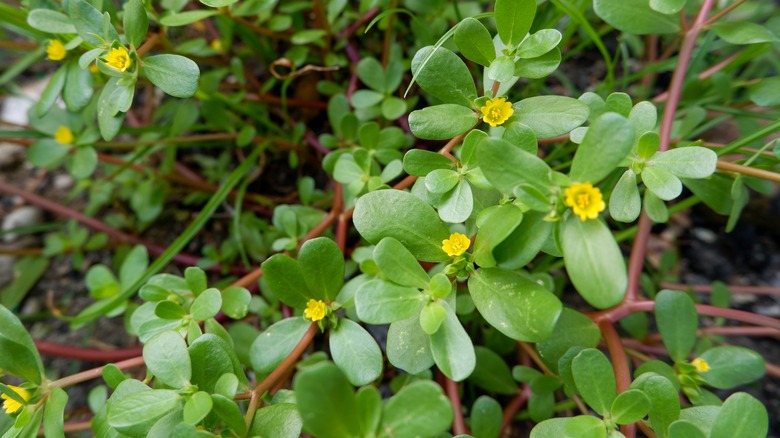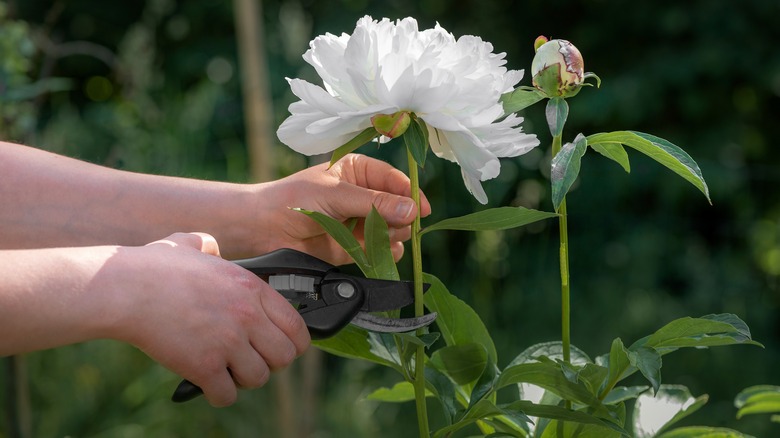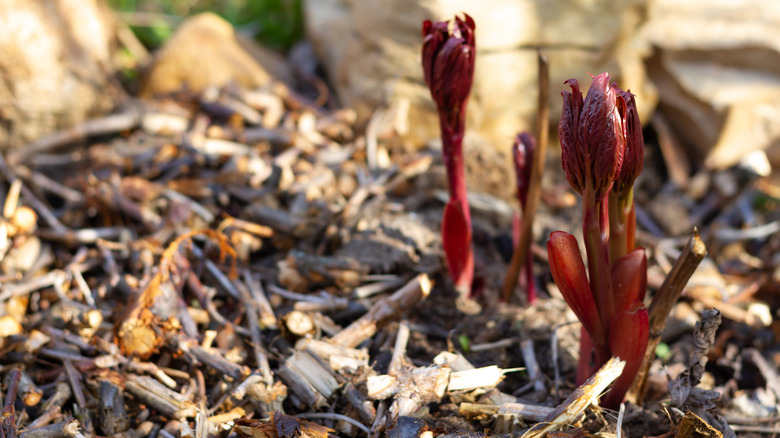Mistakes Everyone Makes When Growing Peonies
With their dreamy, honeyed petals unfurling in an array of graceful forms, peonies (Paeonia spp.) have enraptured the hearts of countless gardeners. Plus, when they lure in beneficial wasps with their floral nectar to pick off grubs invading your gardens, not growing them feels like a missed opportunity. But peonies can be quite the divas, demanding that gardeners work extra hard to enjoy their romantic beauty. Since the one-size-fits-all approach doesn't work for all their varieties, making mistakes is natural. However, it can result in heartache, particularly when the peonies don't bloom properly. Thankfully, planting them right averts most problems, as peonies take care of themselves once established.
For starters, choosing the right variety is important. Despite being hardy in zones 3 to 8, some peony cultivars struggle in southern gardens (zones 8 and 9) because of unmet winter chilling requirements. These stunning beauties require temperatures of under 40 degrees Fahrenheit for at least six weeks to set buds, with a few older varieties as exceptions. So checking the catalog before purchasing is a must. Also, since their love for cold never truly subsides, Southerners must stick to early-blooming cultivars, as they'll have exhausted themselves before the summer peaks. This also explains why you shouldn't plant peonies next to walls, as they tend to overheat as the mercury soars. After you've made your choice, keep an eye out for the following peony-growing mistakes.
Planting peonies in spring
Unless you want to push your peonies into playing catch-up, planting them in the spring isn't the best idea. This is because they are usually budding out actively around this time — if not growing flowers. When forced to settle in new soil and put in their roots, their energies are spread thin, making them weaker and delaying their growth. Due to this, it's quite common for their fragrant blooms to take another year – maybe even two — to show up compared to their fall-planted ilk. But if you've received bare-root tubers in the mail or have overwintered peony transplants in storage, you may plant them immediately in spring (when the ground has unfrozen). However, be mindful that they won't grow vigorously in the first year.
Barring these exceptions, the best time of year to plant peonies is early fall, starting in September and ending short of six weeks from the season's first frost. This will minimize the risk of the plants heaving during the typical freeze-thaw cycles, as the soil will have firmed up by then. In fact, planting sufficiently early gives your plants a greater chance of success, as their feeder roots will have more time to develop.
Not scrutinizing the rootstock's quality
When you plant a stunning flower that can be enjoyed for decades, it's only reasonable that it might take some 'prep time' before enthralling onlookers with gorgeous blooms. However, you risk prolonging your waiting time — by about three to five years in some cases — when you fail to check the roots for their number of eyes (the pinkish-red protrusions on roots), the eye-to-root length ratio, and the overall quality. For instance, a one-eyed tuber measuring 2 inches long can take up to four years to begin showing small flowers. Similarly, buying pre-packs containing soft, squidgy, or wrinkly rootstocks is a bad call, as they might never flower. However, you may get lucky and save a few by knifing out the tender parts and soaking the shriveled ones overnight.
Always choose roots with around three to five eyes (it's an eye if you can put a ring on it). Don't go overboard, as excessive eyes (five or more) make it harder for the roots to support the top-heavy growth later and will keep the flowers small. But if you're already saddled with such a rootstock, divide it. Ensure the crown has at least two roots spanning over ½ inch across and 6 inches long. Also, it shouldn't show any signs of fungal decay or hacking. Look for mature plants with three to five shoots of healthy foliage for pots.
Burying the roots too deep
Plenty of gardeners make the mistake of planting their peonies at the wrong depth, eventually sitting through a season of no-shows. Indeed, the most common reason for peonies not flowering is that they've been planted too deep into the soil. Ideally, the root crown should sit nearly flush with the soil, with the upward-facing eyes buried between ½ to 2 inches underground, depending on the location and variety. So, if you're planting the deer-resistant, herbaceous peonies, you must bury the eyes 2 inches deep if you live in the north. But if you're located in any of the central states, the ideal depth reduces to 1 inch, settling at ½ inch for Southerners.
Since we're dealing with grafts, in the case of tree peonies, it's safe to place them approximately 4 to 5 inches deep underground. This coaxes the plant into developing a new root system instead of depending on the nursery rootstock. However, if you're growing intersectional peonies, bury them ½ and 1 ½ inches deep in warm and cold climates, respectively. Remember, the soil might sometimes settle down, raising the planting depth. To avert such a phenomenon, firm the soil and soak it immediately after planting peonies. If starting with seeds, keep them ½ inch below the topsoil.
Planting peonies in the wrong soil
Just because peonies can adapt to most soils doesn't mean they have to, especially when the stakes involve big blooms. Billy Carruthers, a nursery owner, explained to Good Housekeeping, "The mistake people always make is to keep them [soils] too dry — they think peonies look quite exotic and probably won't need much water." Yet that's a huge mistake since these 'roses sans thorns' thrive in pretty much the same soils that real roses desire: moist, well-draining, and rich. However, there are limits to being moist, too, as a standing pool of water is a huge no-no. That's why unamended clay soils make a poor planting medium, as do sandy soils, since they don't retain much water. Moreover, wet soils are breeding zones for fungal diseases like root rot, white mold, and southern blight that not only kill the infected plants but infect the surrounding vegetation.
So, what's the sweet spot? Loamy soils with pH levels of 6.5 to 7.0. To make clay soils work for you, enrich them with compost or pine bark to improve water permeability, or even better, opt for raised beds. Add lime to low-pH soils to neutralize their acidity. However, work the amendments into the soil before planting, as top dressing isn't as beneficial.
Cutting out the airflow through overcrowding and bad companions
Even though you swear by "more is less" for flower beds, peonies don't. When you plant them too close or in areas where air doesn't enjoy a free-for-all, these flowering perennials suffer. Mix in high humidity and fungal diseases like powdery mildew and botrytis blight have found themselves a direct expressway to your garden. While powdery mildew only messes with your peonies' good looks, blight isn't as forgiving, targeting flowers, buds, and stems, too. Moreover, overcrowding creates leggy stems that contrast poorly with the sumptuous blooms. So, save yourself the dread and space the plants 3 to 4 feet apart. This will also lower the frequency of dividing the clumps, which your peonies will thank you for, as they abhor being displaced and dug out. Who likes leaving their cozy spot?
Follow the same spacing principle for companion planting, as peonies dislike contending for resources, including light, water, and nutrients. For instance, lilacs outcompete peonies by absorbing the same nutrients, while black walnut trees indulge in foul play by releasing toxins, inhibiting nutrient intake. Similarly, tall trees and shrubs shade out peonies, distressing them and affecting flowering. So what can be grown alongside peonies for year-round color? Russian sage, as its lavender flowers hide peonies' dying foliage during summer. Similarly, alliums, purple smoke trees, miscanthus grass, and roses are great options, especially if you're into flower arrangements, given the color echo and textural contrast.
Not providing peonies sufficient sun exposure
If you've ever wondered why your peonies have fewer blooms but somehow last much longer than your neighbors', odds are your plants are protesting over poor sun exposure. Their despondence also adopts the form of long, straggly stems, perhaps in their vain attempt at reaching for the sun. Although it may sound counterintuitive since it's been established that peonies like it cold, the fact is most of them want full sun. Herbaceous hybrid varieties (Paeonia latiflora) — the most common home garden varieties — can't do without at least ½ day of sunlight (via American Peony Society). However, down south, they'll want some protection from the afternoon sun, lest their petals fade out. But if the 6-hour-long sun exposure comes at the price of bracing strong gales, they'll probably want out.
Partially shaded garden owners shouldn't give up hope, as their space may match the needs of tree peonies — another type that's equally (if not more) conscious about suffering sun damage. The three-season stars, or woodland herbaceous varieties, such as Paeonia obovata and Paeonia japonica, prefer dappled shade, especially during the summer. They make splendid understories for deciduous trees.
Neglecting peonies' seasonal water requirements
If you're tired of reading the common tirade, "peonies aren't thirsty plants; they're drought-tolerant; don't overwater them," and have fumbled (or worse, underwatered) while striking that balance, our sympathies. But the grievous mistake of not watering them enough during spring and fall can cost you dearly. The reason? For you to be able to savor their sheer beauty in spring, they must grow new buds. However, a lack of water impedes the buds from opening up and enlarging. In a similar vein, fall is when just transplanted peonies grow almost 80% of their feeder roots, while the established ones continue developing their root systems to support new shoots during the next growth spurt.
So, what's the best method for watering peonies? Slow, deep soaks. You must water the showy beauties around the drip line down to 12 inches, especially during bud development and flowering stages. Repeat the action every 10 to 14 days unless Mother Nature blesses your land with rain, until they go dormant. It will stimulate deeper root penetration, building up drought tolerance. Unless gardening early in the morning, ensure the water doesn't splash on the foliage (no overhead watering) to check mold's presence.
Failing to provide early support
Unless you're planting Japanese or single-flowered peonies, chances are your herbaceous plants refuse to look up from the ground once they're in full bloom. The problem worsens if the rains have dowsed them or the winds have had their way. That's because most of them bloom deliciously massive flowers that their puny stems can barely support, causing the peonies to turn droopy. So, when you skimp on supporting them before they bud out in early spring, you only have yourself to blame for the flop flower show.
While you can keep the show going by pushing four bamboo stakes in the ground and caging the titanic blossoms with twine or tape, a better option is to install a metal, two-ringed, peony cage at the time of planting — not the ones you use for tomatoes, though, as they can't support a mature bloom's weight and may even damage the root crown. These cages train the flowering perennials to grow through the ring and maintain an upright habit no matter what comes their way. If it feels like a tall task, switch over to tree or Itoh peonies, as they remain lightweight throughout their life.
Dereliction of weed management
Even though you would like to forget all about the weeds growing in your yard, the unfortunate news is that they're present and competing with your plants, including peonies, for resources. Left unchecked, the problem can assume gigantic proportions, giving your perennials a run for their money. Nevertheless, the problem is that peonies' feeder roots sit shallowly in the soil. This makes cultivation a tall task since the probability of injuring the underground feeding system is very high.
Thus, to keep weeds down without stunting the plant growth, it's best to use a garden to to get them out. Don't dig deeper than 1 inch around the root crown, although you can go 2 inches deep in the adjacent area to pick out the freeloaders. This also breaks apart the compact soils to enable better drainage and aeration. That being said, while it's fine to layer the soil with landscape fabric and mulch to inhibit weedy development, ensure they're spread thin to allow adequate air circulation and avoid compromising the growth.
Poor fertilization practices
While peonies aren't known to be heavy feeders, such claims are based on the assumption that they'll be grown in organically rich soils. Unfortunately, this isn't always the case, with many following poor enrichment practices without getting a soil test. Peonies must be given a nutrient boost during planting since, when cared for, they can thrive in the same spot for decades. While a balanced 10-10-10 fertilizer can do the job, it isn't the best option, as young plants, particularly their eyes, are susceptible to fertilizer burn.
Instead, spreading a 2- to 4-inch-thick layer of an organic amendment (like pine bark or compost) works better (according to the NC State Extension). You may also supply the soil ½ cup of bone meal to encourage deeper root growth, but place it a few inches away from the tuber. If you insist on using the fertilizer, keep it 6 inches away from the root crown and water immediately after application. Better yet, spread it out in a band starting at around 8 inches from the plant's base and ending 18 inches away.
Avoid fertilizing your peonies in the fall, as it may stimulate new growth, hampering the plant's stride into dormancy and making it vulnerable to winter injury. Instead, fertilize your peonies in spring after their shoots stand 2 to 3 inches tall. Avoid nitrogen-rich fertilizers because they lead to dismal flowering and stem growth while keeping the foliage lush. Give manures a miss, as they share a history with botrytis.
Deadheading too hard, cutting back too early
Another mistake is deadheading peonies too severely. This is done to prevent the plants from wasting resources on producing seeds and using their food stocks. However, such practices may work contrarily, hurting the plant instead if the foliage is sheared off, depriving it of the opportunity to produce more tubers for spring growth. What you need to do is "gently remove the previous year's growth," says Nick Swankie, an expert gardener, in an interview with Saga Exceptional. In other words, deadhead peonies by pinching off the faded flowerheads while keeping the leaves intact. But if you've got plenty of dead flowers, remove them using sharp shears or scissors. Also, don't expect a second flush after deadheading — peonies don't work that way.
Moreover, resist the urge to give your herbaceous and hybrid peonies a haircut in midsummer because you find the dying foliage unsightly. These leaves are pivotal to creating food reserves for next year. Instead, wait for the hard frost to decimate the foliage completely and cut the plant to 3 inches above ground. This will also take care of any fungal spores planning to overwinter in the stems. Err on the side of caution and dispose of the pruned growth rather than composting it, although tree peonies are an exception. This variety grows on old wood and doesn't take kindly to pruning. At most, you can thin them out for five years for improved airflow.
Mulching peonies during winter
In case you missed the memo, peonies are cold-hardy. This implies that you don't need to mulch to keep your peonies healthy and thriving through winter. But if weeds are a constant problem, you can do so in spring before they've had the chance to germinate. It will also keep the soil moist and cool. However, remove the mulch by fall to rob disease-causing microbes of shelter.
That being said, you may mulch newly planted peonies in the first year to provide them with winter protection. As these plants are yet to establish themselves fully, the alternating frost-thaw cycles may cause them to lose their bearings and roll out from the ground. To avert such a scenario, cover the plants' bases with a thin layer of white straw, shredded bark, or pine needles, lest it raise the planting depth, affecting flowering. Don't use peony's dead foliage as mulch or manure unless completely decomposed. Discard the mulch when new stems shoot out. You might have to repeat the process over successive years if you're dealing with young seedlings instead of mature plants. Finally, tree peonies must be winterized with burlap and 4-inch thick mulch in cold climates (zones 4 to 5).












